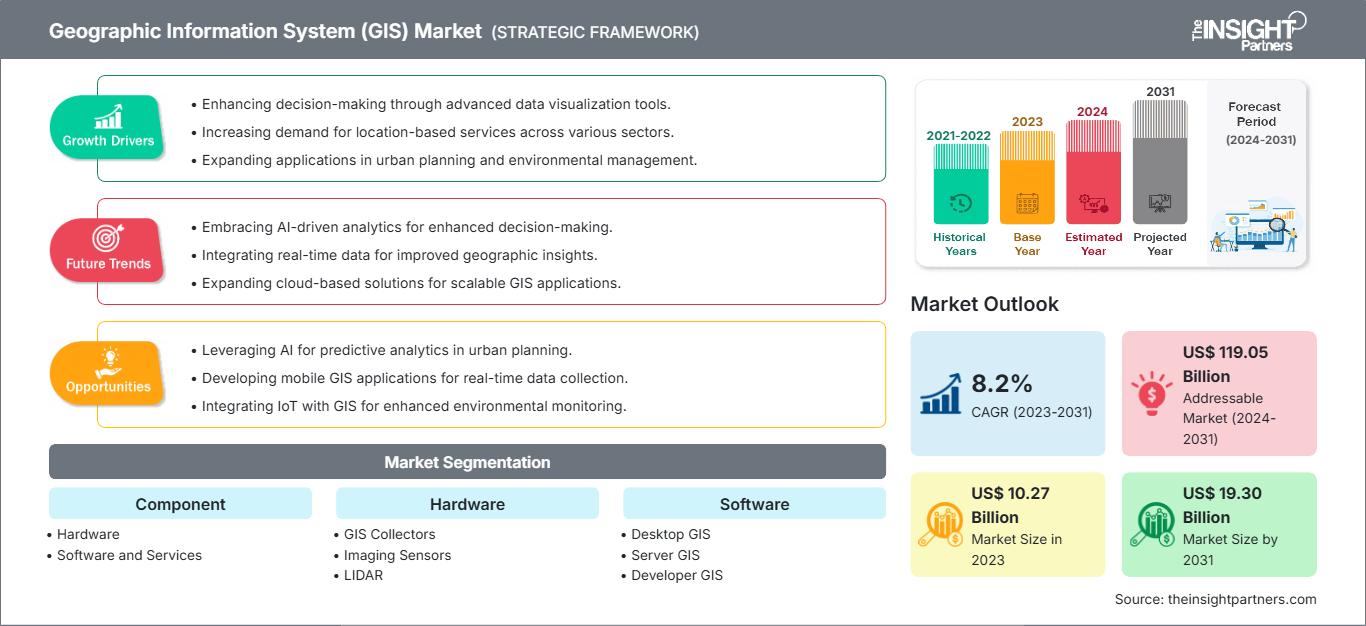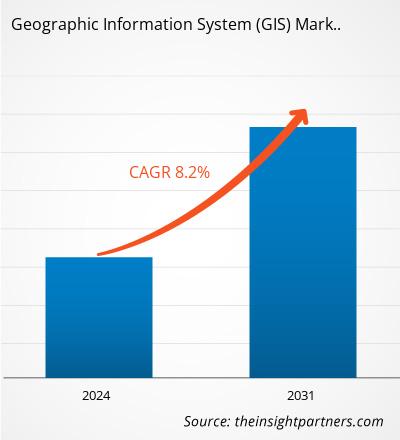地理情報システム(GIS)市場規模は、2023年の102.7億米ドルから2031年には193億米ドルに達すると予想されています。市場は2023年から2031年にかけて8.2%のCAGRを記録すると予測されています。AI、Gen AI、拡張現実ベースのGISソリューションの登場により、今後数年間で市場に新たなトレンドがもたらされる可能性があります。
地理情報システム(GIS)市場分析
地理情報システム(GIS)市場は、自然災害の予測ニーズの高まりにより、予測期間中に大幅に成長すると予測されています。地理情報システムは、暴風雨、ハリケーン、大雨の正確な予測に広く使用されています。重要な空間データ、画像、分析を提供することで、このような自然災害の影響を予測し、軽減する上で重要な役割を果たします。 USAFacts Organizationsによると、米国では毎年65,000件以上の自然災害が記録されています。米国政府は、自然災害の発生を予測するために高度なGISソリューションを使用しています。1980年から2023年まで、米国では400件以上の気象・気候関連の自然災害が記録・発生し、総被害額は2.78兆米ドルを超えました。2024年11月には、10億米ドルを超える被害額が確認された気象関連の自然災害が約24件記録されました。これらの自然災害には、山火事1件、激しい暴風雨17件、熱帯低気圧4件、冬の嵐2件が含まれます。さらに、欧州委員会によると、南ヨーロッパでは2022年に山火事で90万ヘクタールが焼失しました。また、2023年には、主にイタリア、ギリシャ、スペイン、ポルトガルで50万ヘクタール以上が山火事で焼失しました。このような自然災害を回避し、追加的な被害コストを削減するために、地理情報システムの必要性が高まっています。したがって、自然災害を予測する必要性は、地理情報システム市場の成長を促進します。
農家はGISソリューションを使用して、農地データをマッピングし、作物を遠隔で分析、整理、監視します。GPSとGISの統合システムは、農地での作物の収穫量、作物の水分必要量などのリアルタイムデータを収集するのに役立ちます。農家はまた、GISソリューションを使用してリソースの利用率を高め、作物の品種、畑の境界、標高、灌漑システムなどを分析します。したがって、農業分野におけるGISソリューションの採用の増加は、予測期間中に地理情報システム市場の成長に有利な機会を提供すると予想されます。
地理情報システム(GIS)市場の概要
地理情報システム(GIS)ソフトウェアは、大量の情報を統合するために使用され、データを有用な方法で管理および取得するのに役立ちます。 GISのエンドユーザーは、物流・運輸、農業、石油・ガス、建設、鉱業、エネルギー・公益事業など、多岐にわたります。GISは、地理参照情報を保存、統合、編集、共有、分析、表示することができます。ユーザーは、インタラクティブなクエリの作成、空間情報マップの分析、データの編集、そしてこれらすべての操作結果の提示を行うことができます。GISテクノロジーは、様々なリモートセンシング情報と地図を組み合わせて様々なモデルを生成するために不可欠なツールです。GISソフトウェアは、農業科学者が地理データを活用し、農業開発のための計画活動を実施することで、農家へのより良いサービスを提供するための強力なソリューションです。
要件に合わせてレポートをカスタマイズ
レポートの一部、国レベルの分析、Excelデータパックなどを含め、スタートアップ&大学向けに特別オファーや割引もご利用いただけます(無償)
地理情報システム(GIS)市場: 戦略的洞察

-
このレポートの主要な市場動向を入手してください。この無料サンプルには、市場動向から見積もりや予測に至るまでのデータ分析が含まれます。
地理情報システム(GIS)市場の推進要因と機会
物流・運輸・インフラ部門におけるリアルタイム位置情報サービスへの高い需要
2022年の国連報告書によると、世界の物流業界は2023年に約9.4兆米ドルと評価され、2024年には9.9兆米ドルに達し、年間成長率は5.3%になると予想されています。運輸・物流部門では、地理情報システムがライブ交通監視やリアルタイム車両追跡に使用されています。GISは空間データの視覚的表示を使用した監視機能を提供し、監視対象車両の正確な地理的リアルタイム測位を提供します。また、GISマッピングソリューションは、新しい鉄道ルート、道路、その他の輸送ルートを作成するために広く使用されています。世界中で道路や鉄道のインフラ開発への投資は急速に増加し続けています。世界インフラ展望レポートによると、2023年には世界の交通インフラ投資は1兆6,000億米ドルに達しました。地理情報システムは、交通インフラの計画と管理における空間データの分析と視覚化に広く利用されています。地理情報システムは、効率性の向上、コスト削減、安全性と持続可能性など、さまざまなメリットをもたらします。世界銀行によると、世界道路インベントリプロジェクトは、道路インフラに関連する60以上の地理空間データセットで構成されています。このデータセットは約222か国をカバーし、2,100万kmの道路のロードマップが含まれています。地理情報システムは、これらの国の地理空間データを抽出するために使用されます。そのため、物流、輸送、インフラ分野におけるリアルタイムの位置情報サービスへの高い需要が、地理情報システム市場の成長を後押ししています。
農業分野におけるGISソリューションの採用増加
市場のいくつかの主要企業は、農業分野向けに高度な技術に基づくGISソリューションを開発しています。例えば、Ecopia AIは2024年7月、ベクターデータを用いて3D全国土地データセットの新たなレベルを抽出する新たな農地利用データをリリースしました。これらの平面ベクターデータレイヤーにより、政府機関は土地開発、水利用、流出計算、税評価、その他の詳細な分析ワークフローに関連する詳細な地理空間分析を実行できます。同社は2022年に、建物、樹木、農地、橋梁をマッピングするための14の高精度2Dデータレイヤーを提供する3D全国土地被覆をリリースしました。2024年3月、Agribazaarはインドのウッタル・プラデーシュ州に拠点を置く農家向けに、AIベースのGISコマンドセンターを開設しました。このプロジェクトは、ウッタル・プラデーシュ州の75地区にある57,000のグラム・パンチャーヤットの農業データをデジタルで視覚化するために開始されました。
2024年5月、GNSS技術ソリューションのプロバイダーであるCHC Navigationは、Androidデバイス用のデータキャプチャおよびマッピングアプリケーション用の高度なGISソリューションの1つであるMapCloudをリリースしました。このMapCloudは、さまざまな業界のエンジニア、測量士、農家、およびGIS専門家に強力なフィールドデータ収集ツールを提供します。
したがって、農業分野でのGISソリューションの採用の増加は、地理情報システム市場の成長の機会を提供します。
地理情報システム(GIS)市場レポートのセグメンテーション分析
地理情報システム(GIS)市場分析の導出に貢献した主要なセグメントは、コンポーネント、機能、およびエンドユーザーです。
- コンポーネント別に、市場はハードウェア、ソフトウェア、およびサービスに分割されています。 2023年には、ソフトウェアセグメントが市場を支配しました。
- 機能に基づいて、市場はマッピング、測量、テレマティクスとナビゲーション、位置情報サービスに分類されています。2023年には、マッピングセグメントが市場を支配しました。
- エンドユーザーに基づいて、市場は農業、石油・ガス、建設、鉱業、輸送・物流、エネルギー・公益事業、その他に分類されています。2023年には、輸送・物流セグメントが市場を支配しました。
地理情報システム(GIS)市場シェア分析(地域別)
地理情報システム(GIS)市場は、北米、ヨーロッパ、アジア太平洋(APAC)、中東・アフリカ(MEA)、南米・中米の5つの主要地域に分類されています。 2023年には北米が市場を支配し、ヨーロッパとアジア太平洋地域がそれに続きました。
北米の地理情報システム(GIS)市場は、スマートシティインフラ、技術の進歩、業界全体でのアプリケーションの増加など、いくつかの重要な要因により大幅に成長しています。米国とカナダのスマートシティイニシアチブは、公共設備、交通システム、公共サービスの管理にGISを大きく依存しています。また、北米のさまざまな国の政府は、この地域のスマートグリッドインフラを増やすためにさまざまなイニシアチブを取っています。たとえば、2022年9月、米国エネルギー省(DOE)は、国の電力網を強化するために、スマートグリッドおよびその他のアップグレードのプログラムに105億米ドルを投資しました。同様に、GIスマートグリッドプログラムは、クリーン成長と気候変動に関する全カナダ枠組みの目標を推進するための重要なインフラに対処するカナダ天然資源省のターゲットを絞った国家プログラムの1つでした。スマートグリッドプログラムは 2023 年に更新されました。GIS は、強化された監視、正確なモデリング、データ統合、戦略的計画、効果的なコミュニケーションを可能にする、スマートグリッドで広く使用されているテクノロジーです。
地理情報システム(GIS)市場の地域別分析
The Insight Partnersのアナリストは、予測期間を通じて地理情報システム(GIS)市場に影響を与える地域的な動向と要因を詳細に解説しています。このセクションでは、北米、ヨーロッパ、アジア太平洋、中東・アフリカ、中南米における地理情報システム(GIS)市場のセグメントと地域についても解説しています。
地理情報システム(GIS)市場レポートの範囲
| レポート属性 | 詳細 |
|---|---|
| の市場規模 2023 | US$ 10.27 Billion |
| 市場規模別 2031 | US$ 19.30 Billion |
| 世界的なCAGR (2023 - 2031) | 8.2% |
| 過去データ | 2021-2022 |
| 予測期間 | 2024-2031 |
| 対象セグメント |
By コンポーネント
|
| 対象地域と国 |
北米
|
| 市場リーダーと主要企業の概要 |
|
地理情報システム(GIS)市場のプレーヤー密度:ビジネスダイナミクスへの影響を理解する
地理情報システム(GIS)市場は、消費者の嗜好の変化、技術の進歩、製品メリットへの認知度の高まりといった要因によるエンドユーザーの需要増加に牽引され、急速に成長しています。需要の増加に伴い、企業は提供内容の拡充、消費者ニーズへの対応のためのイノベーション、そして新たなトレンドの活用を進めており、これが市場の成長をさらに加速させています。

- 入手 地理情報システム(GIS)市場 主要プレーヤーの概要
地理情報システム(GIS)市場のニュースと最新動向
地理情報システム(GIS)市場は、主要な企業出版物、協会データ、データベースなどを含む一次調査および二次調査を経て、定性および定量データを収集することで評価されます。地理情報システム(GIS)市場における主要な動向をいくつかご紹介します。
- GISソリューションの著名なリーダーであるGEOJobe GIS Consultingは、Oriented Imageryソフトウェアの主要プロバイダーであるAerialSphereとの新たな販売代理店提携を発表しました。このパートナーシップは、AerialSphereの最先端のOriented ImageryテクノロジーをGISコミュニティ内のより幅広いユーザーに拡大するための重要な節目となります。
(出典: AerialSphere、プレスリリース、2024年7月)
- 地理情報システム(GIS)テクノロジーとロケーションインテリジェンスの世界的リーダーであるEsriは、建築、エンジニアリング、建設、および運用(AECO)業界向けのビルディングインフォメーションモデリング(BIM)テクノロジーの世界的リーダーであるAutodesk, Inc.(NASDAQ: ADSK)と協力し、戦略的提携を強化しています。
(出典: Esri、プレスリリース、2024年10月)
地理情報システム(GIS)市場レポートの対象範囲と成果物
「地理情報システム(GIS)市場規模と予測(2021~2031年)」では、市場の詳細な分析を提供しています。下記の分野:
- 調査対象となるすべての主要市場セグメントの世界、地域、国レベルでの地理情報システム(GIS)市場規模と予測
- 地理情報システム(GIS)市場の動向、および推進要因、制約、主要な機会などの市場動向
- 詳細なPEST分析とSWOT分析
- 主要な市場動向、世界および地域の枠組み、主要プレーヤー、規制、最近の市場動向を網羅した地理情報システム(GIS)市場分析
- 市場集中、ヒートマップ分析、主要プレーヤー、地理情報システム(GIS)市場の最近の動向を網羅した業界展望と競争分析
- 詳細な企業プロファイル
- 過去2年間の分析、基準年、CAGRによる予測(7年間)
- PEST分析とSWOT分析
- 市場規模価値/数量 - 世界、地域、国
- 業界と競争環境
- Excel データセット
最新レポート
お客様の声
購入理由
- 情報に基づいた意思決定
- 市場動向の理解
- 競合分析
- 顧客インサイト
- 市場予測
- リスク軽減
- 戦略計画
- 投資の正当性
- 新興市場の特定
- マーケティング戦略の強化
- 業務効率の向上
- 規制動向への対応






















 無料サンプルを入手 - 地理情報システム(GIS)市場
無料サンプルを入手 - 地理情報システム(GIS)市場